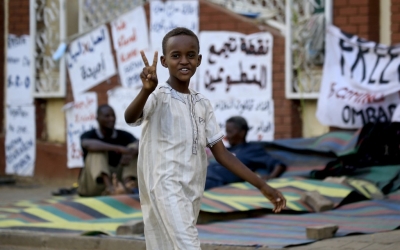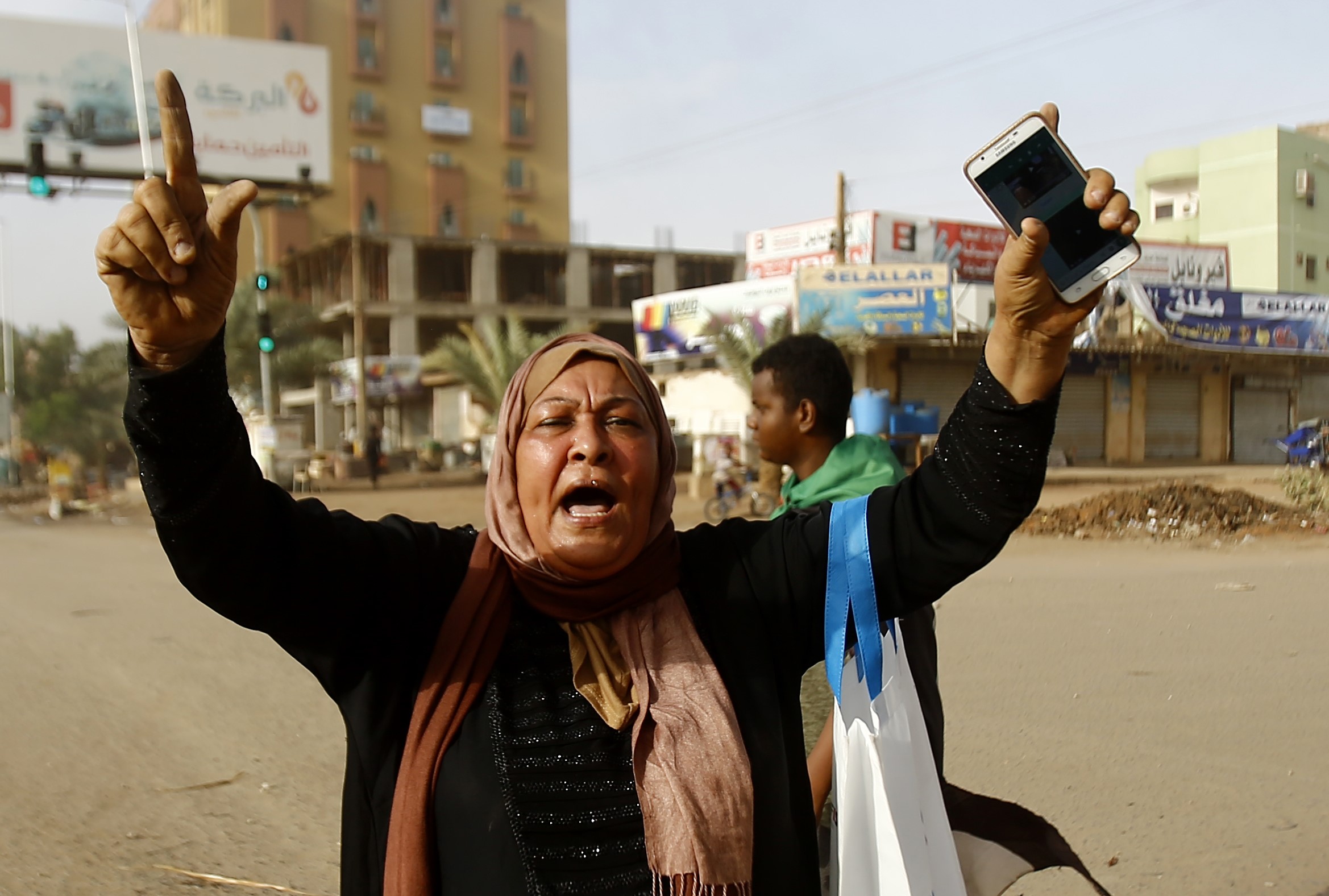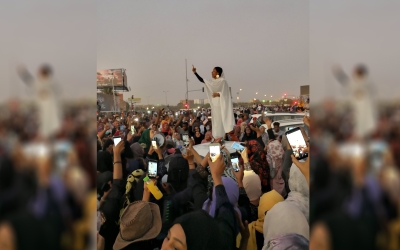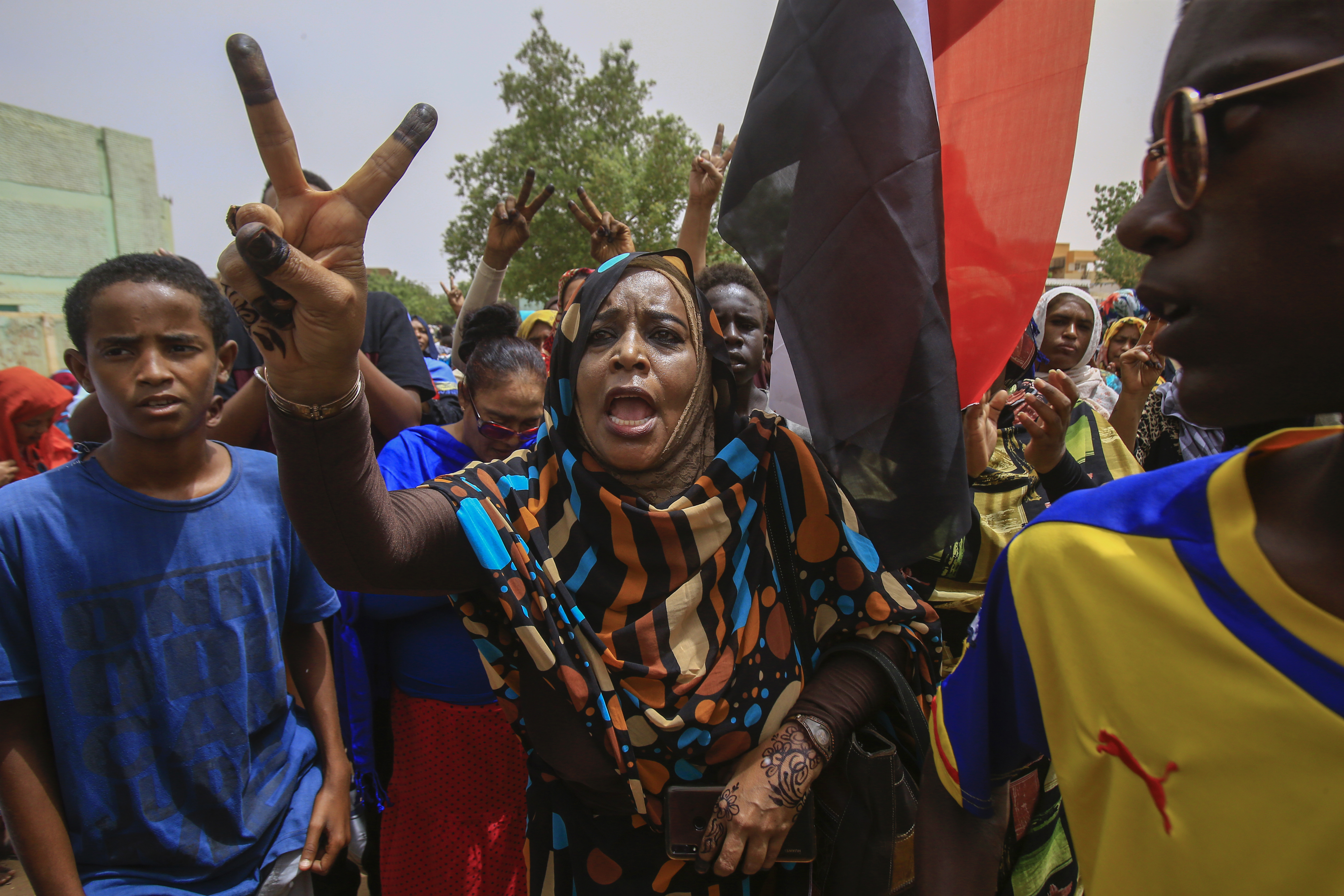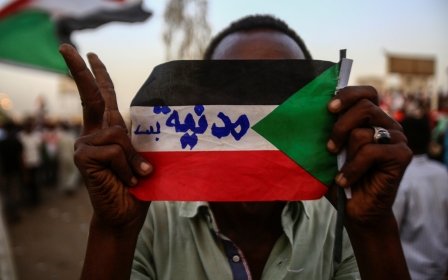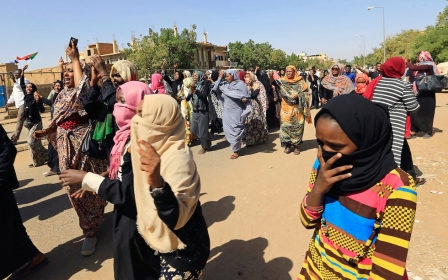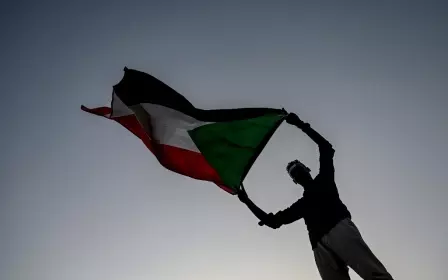Sudan revolution: How women's participation reveals societal fissures
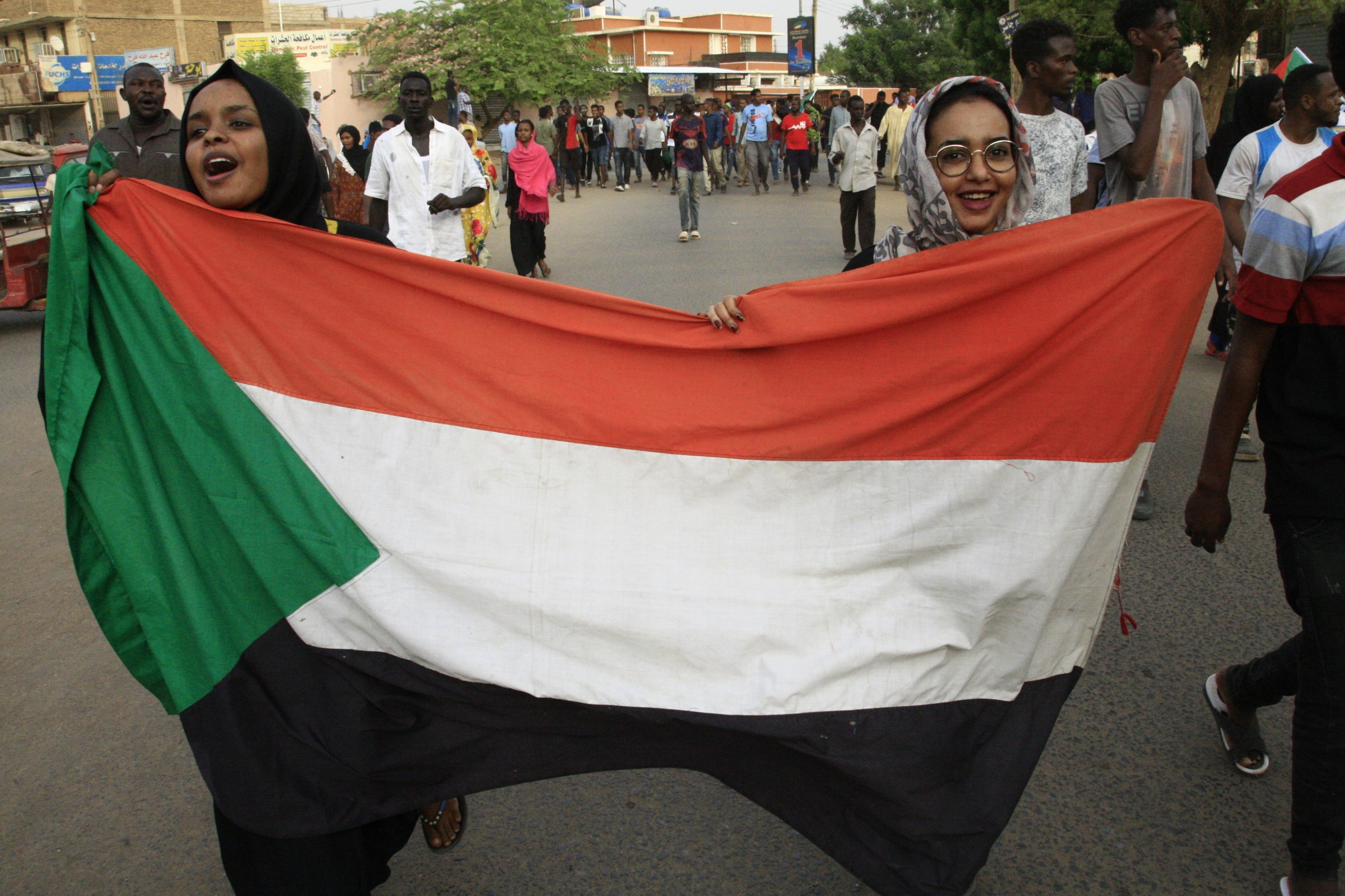
One of the singularities of the uprising in Khartoum was the remarkable visibility of women from all walks of life. The proportion of men to women was quite equitable, but it was perhaps the unexpected presence of young women that led to the hyperbolic depiction of women as being at the forefront.
As the uprising progressed, women stood as gatekeepers to diverse facets of broader Sudanese realities that were intimately tied to its evolution.
The influx of demonstrators at the army headquarters on 6 April created a "terrain of waiting," which existed until it was shockingly dismantled through a massacre of peaceful civilians on the last day of Ramadan. This occurred when the Rapid Support Forces (RSF), due to geopolitical interests, reneged on their promise to refrain from disturbing the sit-in space. The breach caused a deluge of deaths and rapes that tainted the days of Eid.
This transformed Khartoum into a city void of citizens and teeming with RSF troops for at least 10 days. The modus operandi of evacuation had sent waves of horror throughout Sudanese society, so that it came to describe the Eid as Eid shahid (a martyr's Eid) not to be celebrated but rather to be inscribed into the annals of Sudanese history for all the wrong reasons.
A space of hope
New MEE newsletter: Jerusalem Dispatch
Sign up to get the latest insights and analysis on Israel-Palestine, alongside Turkey Unpacked and other MEE newsletters
While it lasted, this protest space amassed huge swathes of the Sudanese population; orators delivering political speeches could be seen alongside youth dancing to hip-hop music. Diverse segments of the Sudanese population congregated around the call: "Either a civilian power structure, or we implant ourselves here eternally."
The sit-in depicted many dynamics and fissures within Sudanese society
Even scorching temperatures could not dissuade protesters from observing the holy month of fasting within this space. The intention of this space was wedded to people's aspirations - but on 3 June, the space of hope was evacuated.
The sit-in depicted many dynamics and fissures within Sudanese society, from the way it was occupied to the manner in which it was dismantled. These were made tangible in the way women invested this zone and their interactions with others therein having a stake in the revolution.
Harnessing majesty and strength
In April, the image of Alaa Salah, a 22-year-old architecture student, chanting to embolden her fellow revolutionaries, went viral on social media. She was framed as the queen of the Sudanese revolution. Yet, there is reason to pause at this portrayal in regards to the messages it conveys about the position of women in the Sudanese revolution.
Two issues in particular warrant comment: Salah's decision to wear a white tobe (a swathe of cloth that is worn over dresses and loosely covers the head and the body) and the attribution to her of the Kandaka, or "queen," title. Both elements reproduce dominant and idealised tropes of Sudanese womanhood.
The likelihood of Salah wearing a tobe in the contemporary era is remote, but she cleverly engages with a symbol of historical pride, manipulating it to serve the aims of the revolution. Her sartorial choice resonates on the national level, giving Sudanese women a place in society that they once occupied as pioneers.
By invoking Kandakas (Nubian queens), Salah's image underscores the penetration of Arab culture into Sudan
This goes back to the foundation of the women's movement, where we see images of young Sudanese women fighting for a place while donning their white tobes, before the country gained independence in 1956. It evokes the establishment of the Sudanese Women's Union in 1952, echoing the achievement of Fatima Ahmed Ibrahim, the first female parliamentarian in the post colonial era in Africa and the Middle East in 1965.
It invokes the possibilities open to other women, giving voice to the efforts of women who were at the forefront of the fight for independence, education and political participation, while preserving an image of female decency.
But while it empowers some, the symbol of the white tobe anchors that of the decent, free-born Sudanese woman, connoting belongings to specific ethnic groups (Nile valley and central Sudan) and therefore militates to render women hailing from alternative ethnic groups invisible.
Sudan's protests: A brief timeline
+ Show - HideSudanese protests have evolved in the space of less than six months from complaints about bread prices to calls for long-term leader Omar al-Bashir to go and demands for a civilian-led transition to democracy.
Here's a summary of the key moments so far since the protests began.
19 December 2018: People take to the streets in the city of Atbara to protest against a government decision to triple the price of bread, torching a local ruling party office. By the next day protesters on the streets of Khartoum and other cities calling for "freedom, peace, justice". Police try to disperse the crowds, resulting in at least eight deaths. Dozens more will be killed in the weeks of protest that follow
22 February 2019: Sudanese President Omar al-Bashir declares a nationwide state of emergency. He swears in a new prime minister two days later, as riot police confront hundreds of protesters calling for him to resign
6 April: Thousands gather outside the army's headquarters in Khartoum, chanting "one army, one people" in a plea for the military's support. They defy attempts by state security forces to dislodge them and troops intervene to protect them
11 April: Military authorities announce they have removed Bashir and that a transitional military council will govern for two years. Despite celebrations at Bashir's demise, protest leaders denounce the move as a "coup" and the protesters remain camped outside army headquarters.
14 April: Protest leaders call on the military council to transfer power to a civilian government
20 April: Sudan's military rulers hold a first round of talks with protest leaders
27 April: The two sides agree to establish a joint civilian-military ruling council, but talks stall over differences in the composition of the council, with both sides demanding a a majority
15 May: With negotiators reported to be close to agreeing a three-year transition to civilian rule, military leaders suspend talks and insist protesters remove barricades outside the army's headquarters. Talks resume on 19 May but break down again on 20 May, with the opposition insistent that a civilian must head the transitional governing body
28 May: Thousands of workers begin a two-day strike to pressure the military rulers and call for civilian government
3 June: At least 35 people killed and hundreds injured, according to opposition-aligned doctors, as security forces firing live ammunition move to disperse the protest camp outside army headquarters
4 June: General Abdel Fattah al-Burhan, the head of the military council, announces that all previous agreements with protest leaders are scrapped and says elections will be held in nine months
By invoking Kandakas (Nubian queens), Salah's image underscores the penetration of Arab culture into Sudan and reinforces a distinct, hybrid northern Sudanese women's archetypal culture, which remains dominant vis-a-vis other women's cultures within the country.
An alternative nomenclature originating in Darfur, such as the title Hakamat (female poets capable of inciting men into war or peace), or Mayram could have been used to represent the archetype of the strong Sudanese woman. But in Khartoum, this was not to be the case, and the honorific title and image of the Kandaka becomes the metonym for the manifestations and multiple histories exhibiting the strength of Sudanese females.
Through excluding some, the image of the Kandaka could become a double-edged sword. Nonetheless, it prevails and builds a bridge between older and younger generations. It represents a past that young women could not access under the rule of the Islamist state, due to its imposition of even stricter legalistic control of female bodies (Public Order law issued in 1996) and not as mere social norms which could and would evolve over time.
Salah, by choosing attire reserved for female civil servants and not typical of her age group, succeeds in harkening back to an era when women were making headway in finding their place within the public arenas of Sudan - to moments that are ephemeral and dreamy, centred on the majesty and strength of Sudanese queens of yore. This boosts the morale of the girls present on the site of the sit-in.
Yet, this representation simultaneously vindicates a nostalgia for an idealised past - as compared with a present in which violations against women and encroachment on their autonomy abound. The image could dangerously obscure the current picture, in which young women are out in the streets exposed to real bullets, throwing back tear gas canisters directed towards the crowds by security forces.
Many young women resisted the reticence of their families to participate in these risky demonstrations.
Fluctuating gender relations and the bedrock of patriarchy
The revolution also provides the possibility for a new reading of gender relationships between young people. Formerly, "Prince Charming" was usually embodied in the figure of a professional man who could offer access to creature comforts. In the space of the sit-in, a shift was taking place, whereby young women were divested of their coy doe-eyed demeanours, loudly proclaiming their desire for men who would not have been serious contenders in the past.
At one point, the young women were clamouring for "army men," drawing a rebuke from other young men in the crowd. After the day of the massacre, however, this romance with the army expired. A poignant video showed a young woman asking an army officer whether he would abandon her, as his sister, to the horrible fate she was witnessing; when he failed to react, she fled.
The rapes that took place over this period also served to expose the fragility of women's empowerment during the six months of the revolution. A latent violence, which had been temporarily silenced, erupted in full force - and in its aftermath, the bedrock of patriarchy proved how solid it was.
The violence exposed nefarious power dynamics, classist distinctions and xenophobic attitudes that have endured within the larger Sudanese landscape
This was evident in some attitudes that differentiated between female and male rape: the latter, although significantly lower in numbers, was considered more reprehensible since it was deemed to unhinge the ideal of masculinity, whereby it feminised men and lowered their social standing and destabilised their ontological masculinity.
The fact that the RSF militias were the primary suspects in these rapes revealed other fissures within Sudanese society, encompassing class and ethnic distinctions.
Frustration drove some disparate but foreboding voices in Khartoum to suggest that the RSF should go back to Darfur, or even say that part of the recruited troops were in any case not Sudanese. Such discourses were to the detriment of more pertinent interrogations relative to their formation in the first place, and why they wielded the power to spread limitless terror.
Conversely, people from Darfur were stating that finally the people of Khartoum were experiencing the horrors that they had endured. Such remarks could only inflame and give life to deeply rooted historical enmities and social hostilities simmering under the surface that the concert in the sit-in space had not completely erased.
RSF commander Mohamed Hamdan Dagalo, aka "Hemeti," denied the rape accusations and pledged to conduct an investigation during an obfuscating speech at a press conference held on 20 June at the Friendship Hall in Khartoum. He claimed he would accept responsibility for the events if found guilty, alluded to fake militia while also stating that his troops lacked adequate training.
Regardless, the violence exposed nefarious power dynamics, classist distinctions and xenophobic attitudes that have endured within the larger Sudanese landscape. These stood in sharp contrast to the ethos of the revolution, which clearly stated in its chants that " ... all the country is Darfur" - a refusal of the state's instrumentalisation of ethnic differences to consolidate its divide-and-rule policies.
Once the current impasse - that of the Transitional Military Council refusing to hand over power to a civilian government - is overcome, difficult conversations will remain the order of the day to consolidate the achievements of the revolution. This must take place to ensure that the lives given up to uphold its values of freedom, peace and justice were not lost in vain.
The views expressed in this article belong to the author and do not necessarily reflect the editorial policy of Middle East Eye.
This article is available in French on Middle East Eye French edition.
Middle East Eye delivers independent and unrivalled coverage and analysis of the Middle East, North Africa and beyond. To learn more about republishing this content and the associated fees, please fill out this form. More about MEE can be found here.



